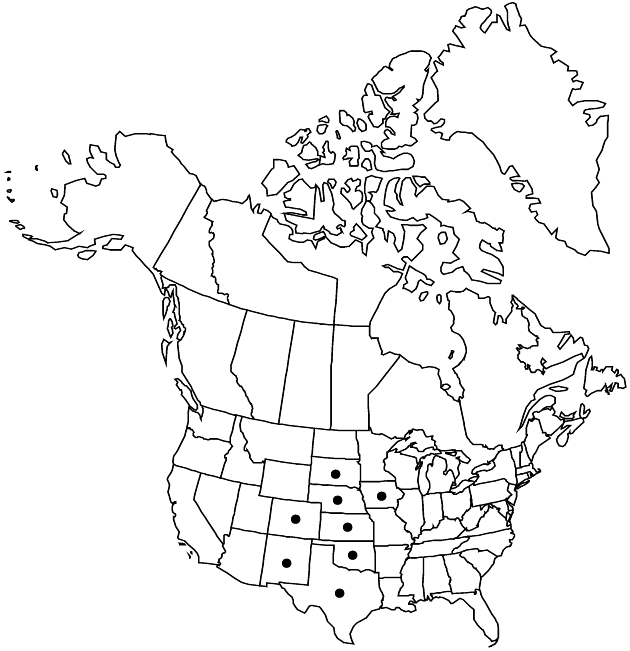Difference between revisions of "Heterotheca stenophylla"
Field & Lab. 19: 68. 1951.
FNA>Volume Importer |
FNA>Volume Importer |
||
| Line 15: | Line 15: | ||
|name=Chrysopsis stenophylla | |name=Chrysopsis stenophylla | ||
|authority=(A. Gray) Greene | |authority=(A. Gray) Greene | ||
| − | }}{{Treatment/ID/Synonym | + | }} {{Treatment/ID/Synonym |
|name=Chrysopsis villosa var. stenophylla | |name=Chrysopsis villosa var. stenophylla | ||
|authority=(A. Gray) A. Gray | |authority=(A. Gray) A. Gray | ||
| Line 31: | Line 31: | ||
|distribution=c;sc United States. | |distribution=c;sc United States. | ||
|discussion=<p>Varieties 2 (2 in the flora).</p><!-- | |discussion=<p>Varieties 2 (2 in the flora).</p><!-- | ||
| − | --><p>Heterotheca stenophylla is divided into two varieties that differ in gland and hair density. Their ranges overlap to a great extent, and intermediates occur throughout the range. Both H. stenophylla and H. canescens often have numerous, overlapping leaves and often bear axillary fascicles of leaves.</p> | + | --><p><i>Heterotheca stenophylla</i> is divided into two varieties that differ in gland and hair density. Their ranges overlap to a great extent, and intermediates occur throughout the range. Both <i>H. stenophylla</i> and <i>H. canescens</i> often have numerous, overlapping leaves and often bear axillary fascicles of leaves.</p> |
|tables= | |tables= | ||
|references= | |references= | ||
| Line 66: | Line 66: | ||
|publication year=1951 | |publication year=1951 | ||
|special status= | |special status= | ||
| − | |source xml=https://jpend@bitbucket.org/aafc-mbb/fna-data-curation.git/src/ | + | |source xml=https://jpend@bitbucket.org/aafc-mbb/fna-data-curation.git/src/8f726806613d60c220dc4493de13607dd3150896/coarse_grained_fna_xml/V19-20-21/V20_539.xml |
|tribe=Asteraceae tribe Astereae | |tribe=Asteraceae tribe Astereae | ||
|genus=Heterotheca | |genus=Heterotheca | ||
Revision as of 15:24, 18 September 2019
Perennials 18–46(–65) cm; taprooted, sometimes spreading by rhizomes, forming additional clumps. Stems 1–50+, ascending to erect (sometimes brown, or reddish to dark brown, often proximally brittle), often short-branched in distal 1/2, sparsely to densely long-hispid and strigose (hairs often broken off, especially proximally), sometimes becoming moderately hairy and densely stipitate-glandular distally (axillary fascicles of leaves often present). Leaves generally ascending, congested; proximal cauline petiolate, blades linear-oblanceolate, (15–)24–42 × (2–)3–6(–8.5) mm, bases cuneate to attenuate, margins flat, entire, strigoso-ciliate, proximally long-hispido-strigose, apices acute, faces sparsely to moderately hispido-strigose and sparsely to moderately stipitate-glandular, or moderately to densely hispido-strigose and eglandular; distal sessile (bright green to grayish green), blades linear-oblanceolate to narrowly oblanceolate (rarely broader), (9–)16.5–30 × (1.5–)2.2–4.3(–6) mm, usually little reduced distally (often surpassing heads), bases cuneate to attenuate, margins flat, often abundantly long-hispido-strigose along whole, apices acute, sometime mucronulate to white-spinulose, faces sparsely to moderately densely hispido-strigose (2–65 hairs/mm²; hairs often scabrous, ± pustulate), usually eglandular, sometimes sparsely to densely stipitate-glandular. Heads (1–)2–16(–30), in corymbiform arrays, branches ascending. Peduncles 2–16 mm, sparsely to densely hispido-strigose, eglandular or sparsely to densely stipitate-glandular; bracts 1–3, proximal linear-oblanceolate to oblanceolate, sometimes little reduced distally, leaflike. Involucres cylindro-turbinate to narrowly campanulate, (4.5–)5.5–8(–11) mm. Phyllaries in 5–6 series, unequal (outer 1/5–1/4 length of inner), narrowly triangular-lanceolate to lanceolate, margins scarious, faces sparsely to moderately strigose, sparsely to densely stipitate-glandular. Ray florets 10–24(–36); laminae (5–)7–11.5(–16.5) × 0.7–1.5(–2.1) mm. Disc florets (12–) 23–55(–70); corollas slightly ampliate, 4.5–7 mm, throats glabrous, lobes 0.4–0.9 mm, lobes sparsely pilose (hairs on lobes 0.1–0.25 mm). Cypselae monomorphic, obconic, compressed, 1.5–2.5(–3) mm, ribs 6–10 (sometimes brownish), faces sparsely to moderately strigose; pappi off-white, outer of linear scales 0.25–0.5 mm, inner of 25–40 bristles (4–)5–6.5(–7.5) mm, longest weakly clavate. 2n = 18, 36.
Distribution

c, sc United States.
Discussion
Varieties 2 (2 in the flora).
Heterotheca stenophylla is divided into two varieties that differ in gland and hair density. Their ranges overlap to a great extent, and intermediates occur throughout the range. Both H. stenophylla and H. canescens often have numerous, overlapping leaves and often bear axillary fascicles of leaves.
Selected References
None.
Key
| 1 | Distal mid stems glabrate to sparsely hispido-strigose, moderately to densely stipitate- glandular; leaf faces sparsely to moderately hispido-strigose, moderately to densely stipitate-glandular (appearing dark to bright green), hair bases often broad (pustulate); phyllary faces usually sparsely strigose and stipitate-glandular | Heterotheca stenophylla var. stenophylla |
| 1 | Distal mid stems moderately to densely hispido-strigose, eglandular or sparsely glandular; leaf faces moderately to densely hispido-strigose, eglandular or sparsely stipitate-glandular beneath hairs (appearing pale green to gray-green), hairs rarely broad-based, pustulate; phyllary faces usually moderately strigose, eglandular | Heterotheca stenophylla var. angustifolia |